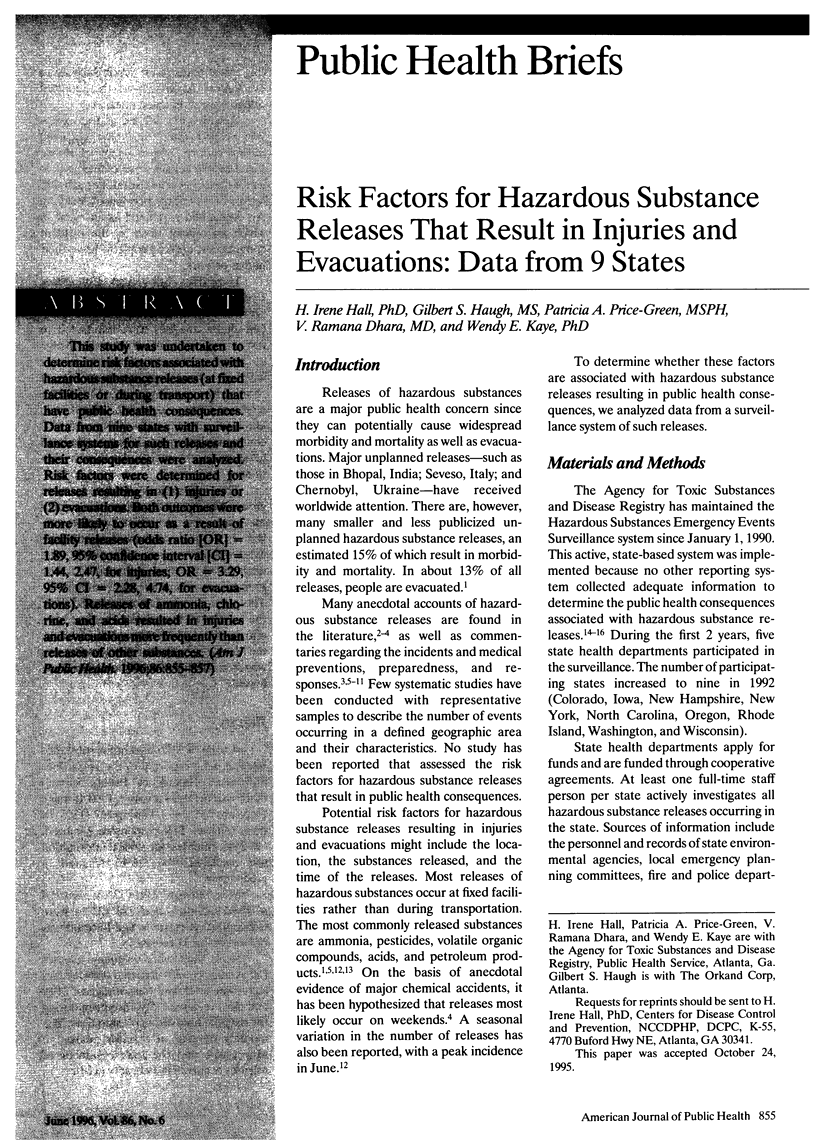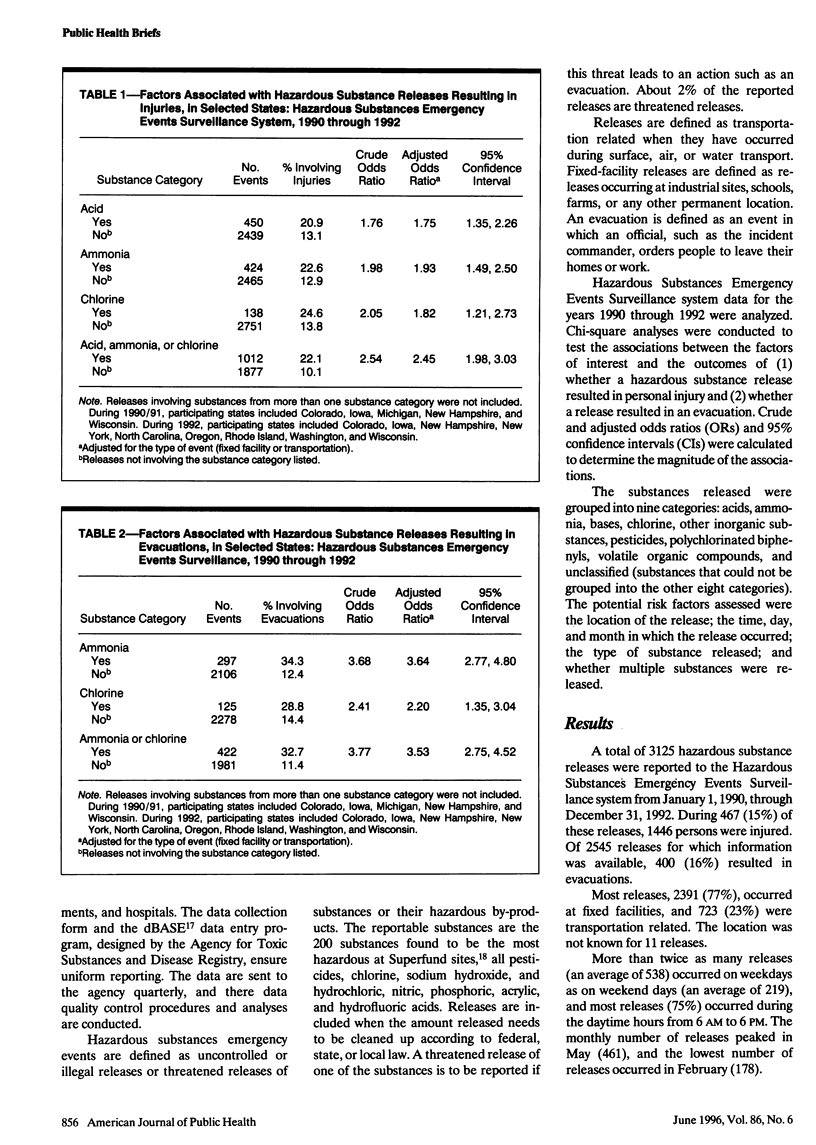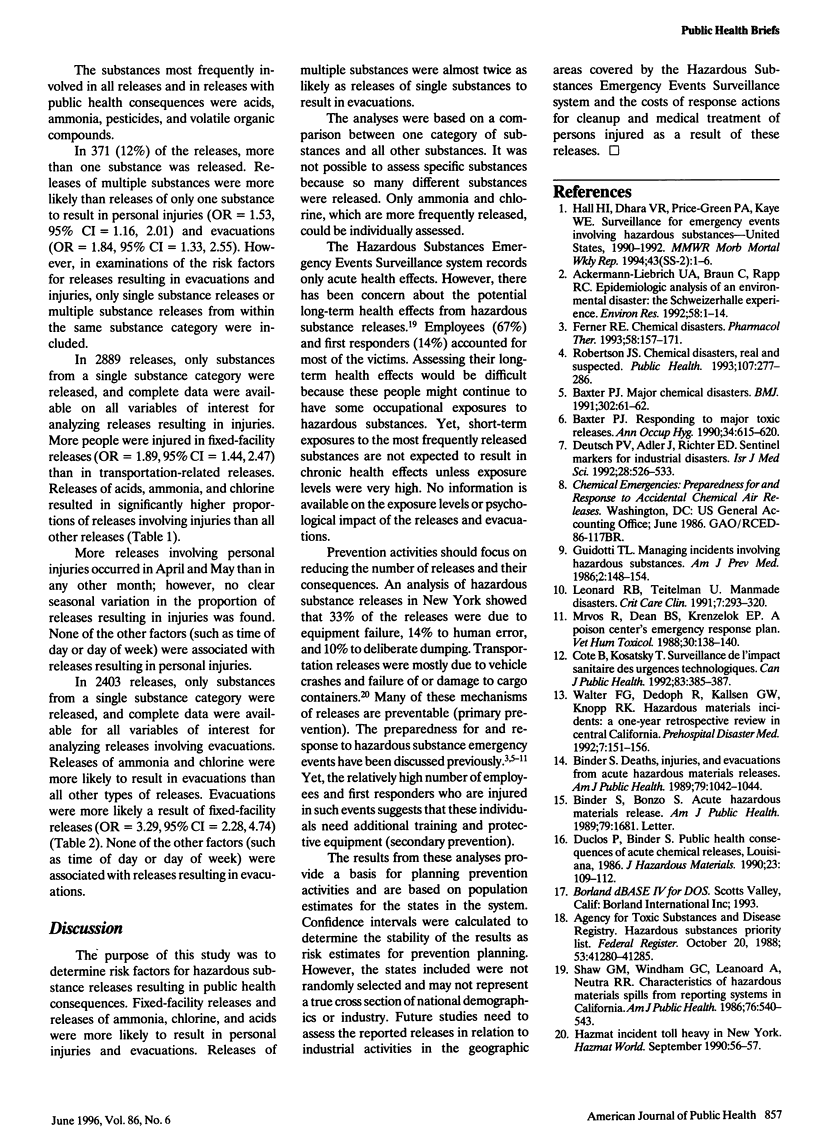Abstract
This study was undertaken to determine risk factors associated with hazardous substance releases (at fixed facilities or during transport) that have public health consequences. Data from nine states with surveillance systems for such releases and their consequences were analyzed. Risk factors were determined for releases resulting in (1) injuries or (2) evacuations. Both outcomes were more likely to occur as a result of facility releases (odds ratio [OR] = 1.89, 95% confidence interval [CI] = 1.44, 2.47, for injuries; OR = 3.29, 95% CI = 2.28, 4.74, for evacuations). Releases of ammonia, chlorine, and acids resulted in injuries and evacuations more frequently than releases of other substances.
Full text
PDF


Selected References
These references are in PubMed. This may not be the complete list of references from this article.
- Ackermann-Liebrich U. A., Braun C., Rapp R. C. Epidemiologic analysis of an environmental disaster: the Schweizerhalle experience. Environ Res. 1992 Jun;58(1):1–14. doi: 10.1016/s0013-9351(05)80200-2. [DOI] [PubMed] [Google Scholar]
- Baxter P. J. Major chemical disasters. BMJ. 1991 Jan 12;302(6768):61–62. doi: 10.1136/bmj.302.6768.61. [DOI] [PMC free article] [PubMed] [Google Scholar]
- Baxter P. J. Responding to major toxic releases. Ann Occup Hyg. 1990 Dec;34(6):615–620. doi: 10.1093/annhyg/34.6.615. [DOI] [PubMed] [Google Scholar]
- Binder S., Bonzo S. Acute hazardous materials release. Am J Public Health. 1989 Dec;79(12):1681–1681. doi: 10.2105/ajph.79.12.1681-a. [DOI] [PMC free article] [PubMed] [Google Scholar]
- Binder S. Deaths, injuries, and evacuations from acute hazardous materials releases. Am J Public Health. 1989 Aug;79(8):1042–1044. doi: 10.2105/ajph.79.8.1042. [DOI] [PMC free article] [PubMed] [Google Scholar]
- Côté B., Kosatsky T. Surveillance de l'impact sanitaire des urgences technologiques. Can J Public Health. 1992 Sep-Oct;83(5):385–387. [PubMed] [Google Scholar]
- Deutsch P. V., Adler J., Richter E. D. Sentinel markers for industrial disasters. Isr J Med Sci. 1992 Aug-Sep;28(8-9):526–533. [PubMed] [Google Scholar]
- Ferner R. E. Chemical disasters. Pharmacol Ther. 1993;58(2):157–171. doi: 10.1016/0163-7258(93)90048-i. [DOI] [PubMed] [Google Scholar]
- Guidotti T. L. Managing incidents involving hazardous substances. Am J Prev Med. 1986 May-Jun;2(3):148–154. [PubMed] [Google Scholar]
- Hall H. I., Dhara V. R., Price-Green P. A., Kaye W. E. Surveillance for emergency events involving hazardous substances--United States, 1990-1992. MMWR CDC Surveill Summ. 1994 Jul 22;43(2):1–6. [PubMed] [Google Scholar]
- Leonard R. B., Teitelman U. Manmade disasters. Crit Care Clin. 1991 Apr;7(2):293–320. [PubMed] [Google Scholar]
- Mrvos R., Dean B. S., Krenzelok E. P. A poison center's emergency response plan. Vet Hum Toxicol. 1988 Apr;30(2):138–140. [PubMed] [Google Scholar]
- Robertson J. S. Chemical disasters, real and suspected. Public Health. 1993 Jul;107(4):277–286. doi: 10.1016/s0033-3506(05)80507-4. [DOI] [PubMed] [Google Scholar]
- Shaw G. M., Windham G. C., Leonard A., Neutra R. R. Characteristics of hazardous material spills from reporting systems in California. Am J Public Health. 1986 May;76(5):540–543. doi: 10.2105/ajph.76.5.540. [DOI] [PMC free article] [PubMed] [Google Scholar]


